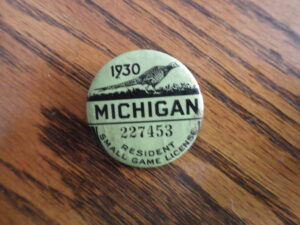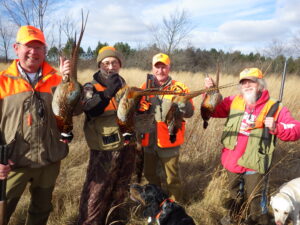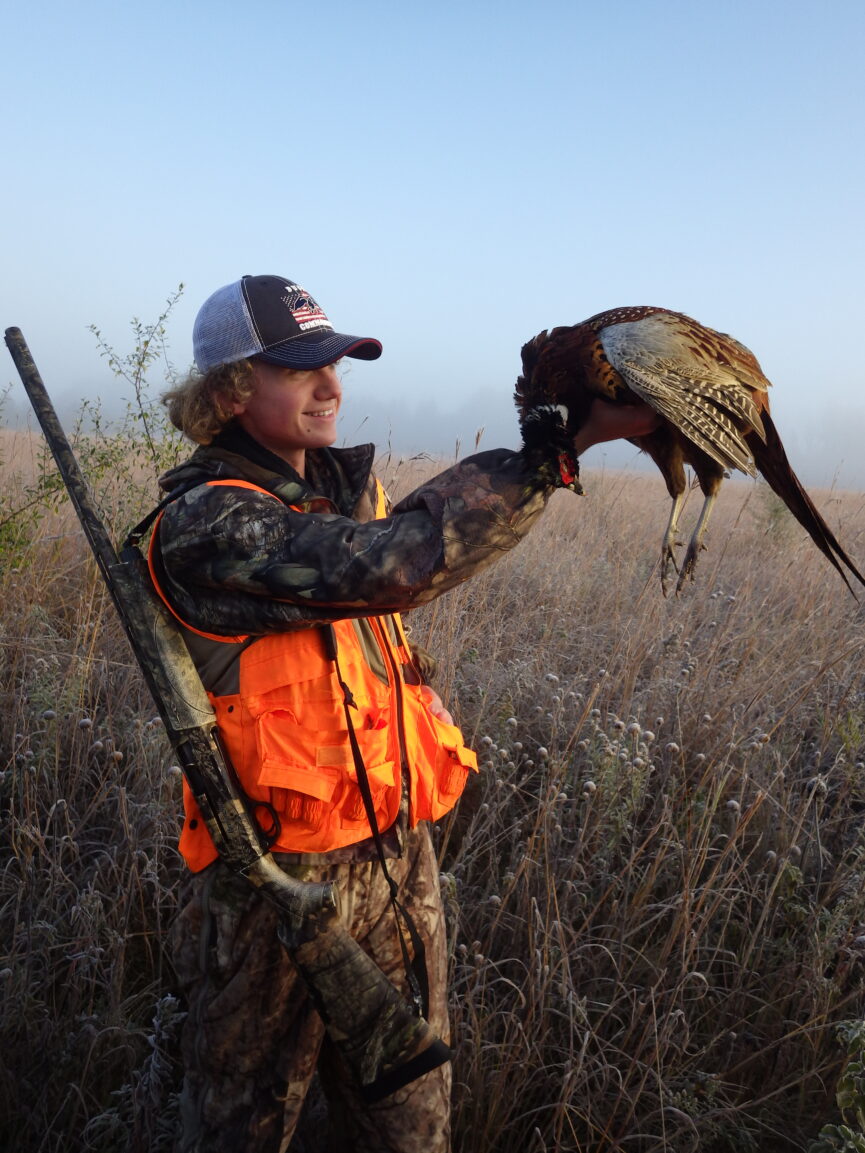Pheasants were first released in southern Michigan in 1917. The pheasants being released were pen-reared birds of mixed blood known as “ringnecks” which owe their origins to eastern U.S. game farms, that in turn had gotten their original eggs from game farms in England. Those first birds were released into an ideal environment quite unlike what we have today and would readily adapt and propagate. The first official Michigan pheasant hunting season occurred in 1925 and it would be the beginning of a highly popular annual event. It became so popular that small game hunters far outnumbered deer hunters, with Michigan becoming the top pheasant hunting state in the nation during its heyday.

The 1930 Michigan small game license was a ceramic and brass pin featuring a rooster pheasant, the king of small game.
My late father was born in 1913 and grew up on a Thumb farm. He could remember when the first pheasants were released and how during the 8 years that the pheasants could not be hunted for them to become established, the flourishing number of birds became nuisances at times. This included eating freshly planted seeds and busting limbs off fruit trees in the orchard due to too many pheasants roosting on them at night. My father would also take part in the first pheasant season, and it would be his main hunting pastime until the wild pheasant population crash of the 1960’s.
Being the fourth generation to own the family farm, I grew up during the annual pheasant hunting atmosphere starting in 1952 (this was the first year it opened on the 20th as prior to that it opened on the 15th of October) at age 3 when I was my mother’s “pooch” while she downed roosters with her single-shot Iver Johnson 20 ga. Needless to say, pheasant hunting is deeply entrenched in my being and I feel blessed to have witnessed those days in the 1950’s when schools were closed for the pheasant hunting opener and the local economy truly flourished due to the sudden influx of avid pheasant hunters, many from urban settings.
I can remember our farmyard looking like the parking lot of the county fair and entailing numerous hunting dogs yapping and excited to be in the field. Many of the hunters were factory workers from the big cities and this was an annual holiday they looked forward to each year. A goodly number were World War II veterans who were from the South and had moved to Michigan to find employment. They knew all about hunting dogs and how to shoot and were great gentlemen for a kid to share the field with. Much of what I know about pheasant hunting techniques, dogs and guns, I learned from them.

Pheasant hunting represents plenty of camaraderie in the field being shared with fine hunting dogs.
I also remember when wild pheasant numbers suddenly dropped, and with it so did the number of visiting hunters, which didn’t help the local economy. I also remember when schools didn’t close for the pheasant opener, much to my dismay and forcing me to play hooky. I never gave up on local pheasant hunting, and October 20th remains a treasured day for me.
Due to the dramatic habitat change which was caused by modernized farming practices, the pheasants I hunted were found in smaller pockets of habitat which allowed them to survive and propagate in limited numbers. I began to refer to them as “pocket roosters”, which are challenging to hunt because they have evolved into a unique bird which is unlike the roosters I learned to hunt in my youth. The pocket roosters will run and zigzag around with the speed of a roadrunner and flush and fly only as a last resort and rarely cackle when flushed. Since they usually don’t hold long for a pointing dog, I prefer to use flushing dogs with pointing dogs, a particular technique I learned from the visiting hunters of my youth, which is very similar to quail hunting techniques used in southern states.
I saw pheasant numbers begin to blossom in the 1980’s when CRP came into being and put croplands into grasslands, which is the pheasant’s preferred and required habitat, and I’ve seen pheasant numbers dramatically drop when rising commodity prices put grasslands back into crop production. Properly maintained grassland is the key element to promoting and propagating wild pheasants and it is why I have devoted my farm to this process. I also fully support Pheasants Forever (PF). However, with today’s intense agricultural practices which include very effective herbicides and insecticides, as well as fall plowing, the atmosphere of the heyday of pheasant hunting and its widespread environment I remember as a kid, is only a fond memory. However, I believe in maintaining the pheasant hunting heritage in any way feasibly possible.
Deer hunting is now at the top regarding the number of Michigan participants and small game hunting is at the bottom, as well as private properties are being managed for deer hunting. It seems if the average hunter doesn’t own the ground, lease it or belong to a club that owns or leases it, he or she has the only option of hunting public land. Fortunately, southern Michigan is blessed with plenty of public land, including the Thumb. I also feel blessed to have my own ground for my family and friends to hunt, and I’m fully aware that a whole lot of folks don’t have that advantage, many from an urban setting.
The “Michigan Pheasant Hunting Initiative” (MPHI), which was started as a grassroots effort by devoted pheasant hunter Ken Dalton of Lapeer, held the first hunt during the 2019 pheasant season. Top quality rooster pheasants were provided by the Michigan Game Bird Breeders Association and released in cooperation with the MDNR during October and December on 11 State Game Areas (SGA) in southern Michigan. The release dates were never known by the public, and birds were let loose after hunting hours. According to all reports, the involved SGA parking lots were packed full during pheasant season, which says a lot for the popularity of this new program. The top priority of MPHI is hunter recruitment and retention, especially in regards to small game hunting, which has been steadily falling by the wayside in recent years.
There is nothing new about this concept and a prime example is South Dakota, the number one pheasant hunting state, which releases over six hundred thousand pen-reared pheasants annually to bolster bird numbers. Certainly South Dakota offers wonderful pheasant habitat and a great number of wild birds, but it seems with so many visiting hunters from other states, which certainly helps to bolster the state’s local economy (it’s state bird is a rooster pheasant) , that demand might exceed what the wild can provide. There is no question that South Dakota looks upon pheasant hunting as being economically important, to the tune of over 230 million dollars annually.
For more information about the Michigan Pheasant Hunting Initiative and the list of 13 participating SGAs, go to michigan.gov/smallgame or call Ken Dalton, who goes by “Mr. Pheasident”, at 810-358-9372. A pheasant license is required for hunters 18 years or older on all public lands in the Lower Peninsula.
Yep, folks, I’m looking forward to celebrating Michigan’s 100th year of a pheasant hunting heritage.
- Fickle weather during December deer hunting adventures - December 3, 2025
- Michigan’s most popular opening day – November 15th - November 23, 2025
- A missing dog found while anticipating opening day - November 23, 2025

